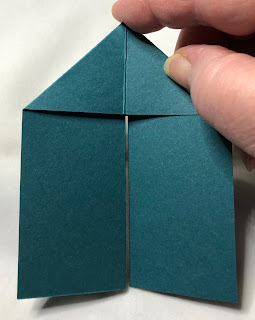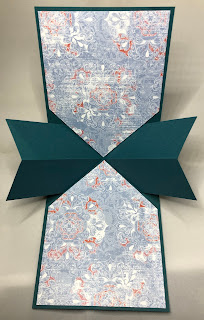I've not been looking forward to this one as it's a bit fiddly to make, but it wasn't too bad after all. It's called a Twisted Pop-Up Card and I've included the instructions below. It's quite a spectacular card to open and people are always impressed when they do so.
Card 1
I used Ready to Ride Designer Series Paper and Something Fancy Stamp Set for this one.
Card 2
This one uses He's the Man Designer Series Paper and Beside Me Stamp Set. I also added some clouds from the Playing in the Rain Stamp Set. I coloured the images with Stampin' Blends and Stampin' Write Markers.
 |
How To Make This Card
Note: the photos show a different card because I had already written instructions for a class a little while back.
Materials
- 12" x 12" coloured cardstock, or 2 pieces of A4 (card base, pup-up mechanism and focal piece)
- A4 contrasting cardstock (labels and mats, if used)
- 12" x 6" coordinating Designer Series Paper
- Embellishments, as desired
Instructions
1. Cut base cardstock (card base): 11" x 4¼", score at 5½" on the long side. Fold the piece into a top-fold A2 card.
2. Cut three pieces of DSP 4" x 5¼”. They can be all the same or all different or any combination thereof. Put two pieces aside for later (Step 9). Adhere the other piece to the front of the card and decorate the card front as desired. This can be done later but may be easier to do at this time while the card base it totally flat.
3. Cut plain cardstock for the pop-up mechanism, 3" x 8". Score down the centre of both sides, i.e. at 4" on the long side and 1½" on the short side.
4. Mark at 2½" from each corner with a pencil, at the top and bottom edge of the cardstock. Score an X from mark to mark. The centre of the X should match the centre of the cardstock where the other score lines intersect.
5. Burnish all score lines with a bone folder, folding both ways.
6. Push the long centre score lines toward each other until they meet. Fold the sides back. The centre X should form triangles front and back, with the folded sections inside, and the folded edges together. The folded pop-up mechanism should look like the second photo.
7. Mark the centre point on the fold of the card base at 2⅛". Centre and adhere one side of the pop-up mechanism, gluing only the triangular area. Close the card to be sure the point does not interfere with the fold. Make sure that the insert is straight (check the sides of it against the sides of the card).
8. Add adhesive to the triangle facing upward, and close the card to adhere it into place. Allow the glue to dry, and test the pop-up mechanism by opening and closing the card.
9. Take the two pieces of DSP cut earlier (in Step 2) for the inside of the card (both should be 4” x 5¼"). Mark at 2” on one short side and 2” down on each side. Be aware of which way up the pattern needs to be. Cut from the side points up to the centre point to shape panels that will fit inside the card and cover up the central part of the pop-up mechanism.
10. Adhere the panels to the inside of the card.
11. Cut cardstock for the focal piece, 3¾" x 11”.
a. Score at 2¾" from each end on one side.
b. Flip the cardstock to the right side and score at 5½".
12. Fold the panel into a W shaped booklet and burnish the folds.
13. Cut four pieces of contrasting cardstock, 2½" x 3½”. This, coincidently, is the same size as an ATC, so you could use ATCs you have received, or make a series of related ATCs and use them here. You could also just use pieces of DSP on the panels, if you want.
14. To assemble the card, centre the booklet at the top of the open card (this is the back of the card front), with the opening upwards just inside the edge, and the back ‘page’ facing up. In the photo below, the top of the booklet is to the right. Place it at the top of the card so that it opens fully when the card is opened, and make sure it’s centred across the card.
15. Close the card to see where the mechanism meets the booklet. Place some adhesive on the left side of the mechanism and close the card and wait for it to dry. It's best to use Multipurpose Liquid Glue to allow for a little movement.
16. Now place the mechanism BEHIND the booklet and repeat as above.
17. Close the card, making sure the mechanism folds the right way. Press down to secure the adhesive and allow the project to dry completely.
18. Cut a piece of light or white cardstock 2" x 3" and adhere it to the bottom of the opened card (for writing your message onto).
19. Embellish as desired.
The card will fit in a standard A2 envelope. Depending on the thickness of the layers, it may need extra postage.
Have a try, it does look really good. If you have any problems, let me know and I'll try to help.
Back tomorrow.
Happy crafting.

















No comments:
Post a Comment